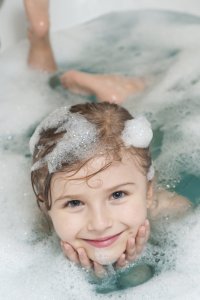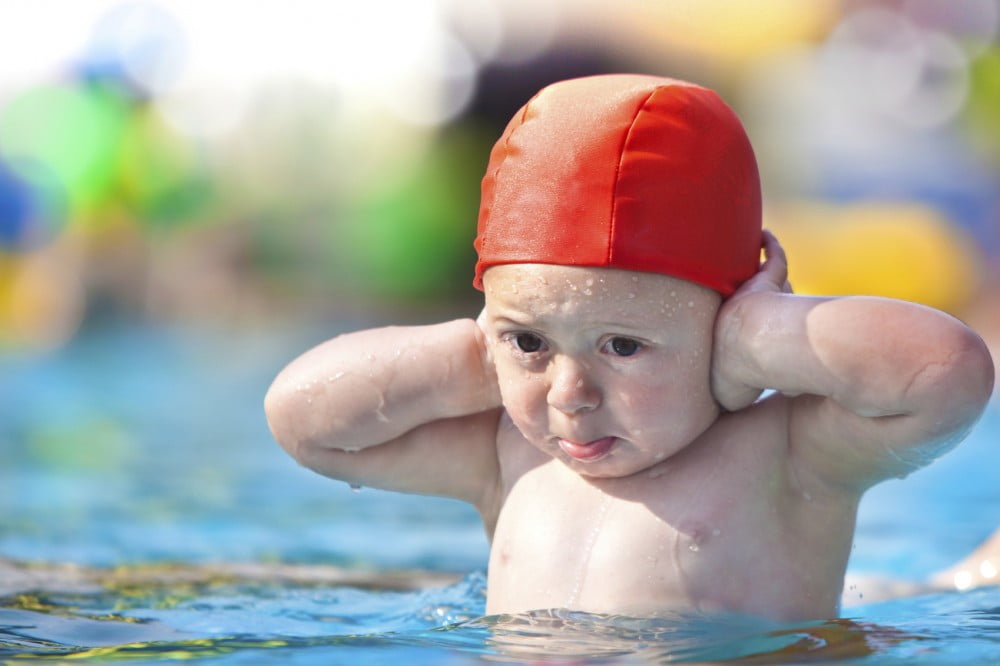In this blog, Professor Martin Burton looks at the evidence on water protection for children with grommets and says it’s time for a fresh look at the advice given to parents.
Page last checked 24 August 2022.
Many children have grommets (ventilation tubes) put in their ears. This is done when they have a common condition called “otitis media with effusion (OME)”. This is often referred to as “glue ear” because a sticky, yellow glue-like liquid gets trapped behind the ear drum. It can lead to hearing loss and ear infections. In most children, grommets are only put in if the problem is persistent, lasting for three months or more, and causing difficulties for the child.
Should ears with grommets be protected from water?
In the past, some health professionals would tell parents not to let their children swim or get their heads wet in the bath or shower. They would suggest using swim-plugs bought from the pharmacist or plugs made of cotton wool balls covered with Vaseline to keep water out. The thought was that if water got into the ear, and passed through the hole in the grommet into the middle ear (the air-containing space underneath the eardrum), the child might be at riskA way of expressing the chance of an event taking place, expressed as the number of events divided by the total number of observations or people. It can be stated as ‘the chance of falling were one in four’ (1/4 = 25%). This measure is good no matter the incidence of events i.e. common or infrequent. of an ear infection. But not everyone gives the same advice. Some people believe that the hole in a grommet is so small (less than a millimetre) that it’s very difficult for normal water to get through. So there should be no restrictions on swimming of bathing. Then there is also the thought that soapy water (from the bath or during hair-washing) might more easily go through the hole than non-soapy water. So – what you do should depend on the type of water!
New evidence can help you make a choice

A Cochrane Review Water precautions for prevention of infection in children with ventilation tubes (grommets) (published in January 2016) found two studies looking at this topic. The authors looked at how likely it was for a child to get a runny ear (technically called “otorrhoea”) if they used ear plugs or avoided water altogether. They concluded that there was quite reliable evidence that if a child wore plugs they would have – on average – 0.84 episodes of runniness per year if they wore plugs, compared to 1.2 episodes if they didn’t. The difference – less than half an episode a year (you may think of that as one episode in two years) – is not very much.
What about avoiding water rather than using plugs: no swimming or putting your head under the water in the bath? The results of this studyAn investigation of a healthcare problem. There are different types of studies used to answer research questions, for example randomised controlled trials or observational studies. are less reliable but there was no difference in the average chance of getting a runny ear; 1.17 episodes per year in both groups.
It’s worth bearing in mind that all these numbers are small; runny ears are not apparently common if you have grommets no matter what you do. The trialClinical trials are research studies involving people who use healthcare services. They often compare a new or different treatment with the best treatment currently available. This is to test whether the new or different treatment is safe, effective and any better than what is currently used. No matter how promising a new treatment may appear during tests in a laboratory, it must go through clinical trials before its benefits and risks can really be known. tells us that on average children only get about one episode of runniness in 14 months even if you do nothing. How big a problem is this? Is it worth all the hassle of putting plugs in of avoiding swimming for the sake of avoiding that one episode? In some countries with warm weather, lots of swimming pools in homes and year-long beach activities it is critically important that children learn to swim if they are to be safe.
It is time for health professionals to take a fresh look at the advice they give to parents. Many will probably find it a merciful release not to have to struggle with squirming children who hate wearing swim caps, bands and plugs. And their children will be no worse off.
More about hearing conditions
On this page Hearing conditions: evidence, experience and resources (March 2023) we share trustworthy evidence and resources about hearing conditions and highlight opportunities to take part in research. Our blogs help to set evidence in context and make it easy to understand, and often include reflections from people living with hearing conditions and from health professionals and researchers.
Join in the conversation on Twitter with @CochraneUK or leave a comment on the blog.
Please note, we cannot give specific medical advice and do not publish comments that link to individual pages requesting donations or to commercial sites, or appear to endorse commercial products. We welcome diverse views and encourage discussion but we ask that comments are respectful and reserve the right to not publish any we consider offensive. Cochrane UK does not fact-check – or endorse – readers’ comments, including any treatments mentioned.
Reference and links:
Moualed D, Masterson L, Kumar S, Donnelly N. Water precautions for prevention of infection in children with ventilation tubes (grommets). Cochrane Database of Systematic ReviewsIn systematic reviews we search for and summarize studies that answer a specific research question (e.g. is paracetamol effective and safe for treating back pain?). The studies are identified, assessed, and summarized by using a systematic and predefined approach. They inform recommendations for healthcare and research. 2016, Issue 1. Art. No.: CD010375. DOI: 10.1002/14651858.CD010375.pub2.
Plain language summary: http://www.cochrane.org/CD010375/ENT_water-precautions-prevention-infection-children-ventilation-tubes-grommets


